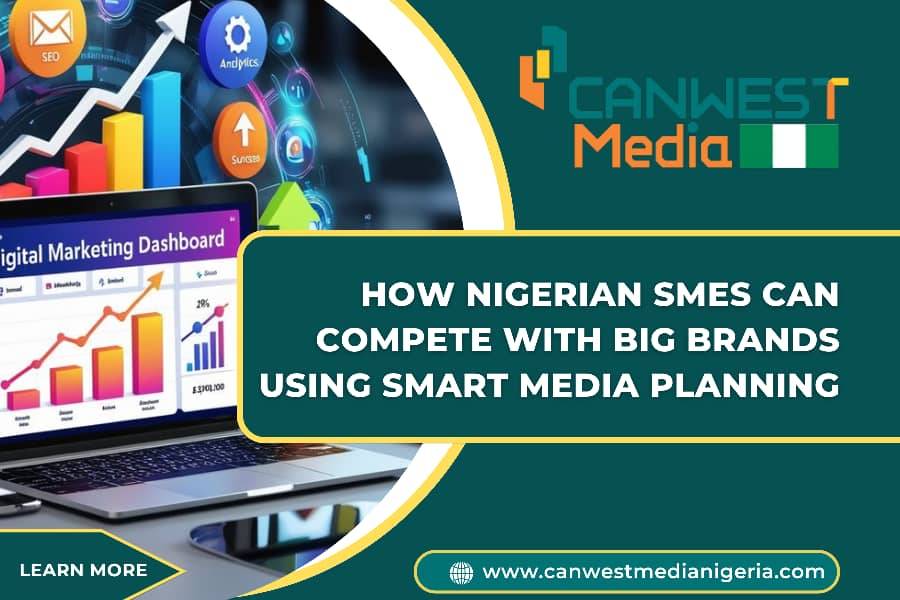
How Nigerian SMEs Can Compete with Big Brands Using Smart Media Planning
Introduction
Nigerian small and medium sized enterprises (SMEs) are fighting in an unfair ring. The big brands have million-naira budgets, billboard dominance, celebrity influencers, and flashy campaigns that dominate TV and radio. However, with the rising cost of traditional advertising and the shift in consumer attention toward digital and localized platforms, media planning has become a critical differentiator.
Smart media planning enables SMEs to leverage limited budgets for maximum impact by focusing on targeted messaging, efficient channel use, data driven decisions, and audience segmentation. Today, strategy is your strongest currency, with smart media planning, hyper targeted content, localized storytelling, and data driven choices. Nigerian SMEs can not only compete with big brands, but even outperform them in niche markets, here’s how your SME can win big by thinking smart with your media spend.
1. Combine Online & Offline Creatively:
Offline channels still influence trust and recall in many Nigerian cities, when connected strategically to digital platforms, through scannable links, social handles, or incentives, they serve as an affordable bridge between brand awareness and customer action. By creatively integrating both offline and online channels, small businesses can extend reach, reinforce brand recognition, and drive conversions at a fraction of big brand costs.
Instead of investing in high-cost options like billboards or TV placements, SMEs can consider low cost, high impact alternatives such as mounting street banners in front of local stores or vendor stalls, making branded packaging like paper bags, nylon wraps, or takeaway boxes that include QR codes or Instagram handles. You can also Partner with Keke and Okada riders, using branded seat covers or flyers for local delivery routes and majorly, work on offline promotions that lead to online action.
2. Focus on Audience Precision Over Mass Reach:
Large brands typically aim for mass visibility, but SMEs can compete by narrowing their target and speaking directly to the most relevant audience segments, through tools like Facebook Ads Manager and Google Audience Insights, SMEs can define their target audience by location, interest, gender, language, and behavior patterns. Be nimble and create short, impactful micro-campaigns tied to local happenings and run a targeted social media campaign offering discounts.
3. Storytelling Beats Shouting:
Storytelling allows small businesses to build trust, emotional connection, and brand loyalty by showing the human side of their operations, the challenges, the passion, the process, and the people involved. Big brands rely on loud, high frequency messaging, SMEs can achieve deeper audience connection through authentic storytelling.
Today’s consumers, particularly on platforms like Instagram and TikTok, are more responsive to relatable, behind the scenes content than polished ads. They connect more with personality and process, by embedding storytelling into your content strategy, your brand becomes more memorable and trustworthy, even without a massive advertising budget.
4. Leverage Timing to Avoid Competition Clashes:
A lot large brands typically focus their campaigns around national holidays and major events, SMEs can maximize visibility by targeting off peak periods or less saturated timeframes. Running campaigns during quieter seasons or in between high traffic windows allows SMEs to capture audience attention with less noise and more cost efficiency.
Engagement levels can increase significantly when the market isn’t saturated with multiple brand messages. Timing plays a critical role in visibility, by strategically planning campaigns during less competitive periods, SMEs can lower ad costs and achieve higher impact with the same or smaller budgets.
5. Adopt a Local Influencer Strategy:
Rather than investing in high fee influencers with national reach, SMEs can collaborate with nano and micro influencers who have high engagement within specific communities. These influencers typically have stronger, trust-based relationships with their audiences, making their recommendations more persuasive. They are also more open to barter deals, discounted rates, or long-term brand relationships, providing SMEs with flexible and cost-efficient exposure.
Conclusion
By embracing these smart media planning strategies, Nigerian SMEs can effectively compete with big brands. It’s not about having the biggest budget, it’s about having the sharpest focus, the deepest local understanding, and the most authentic connection with your customers. Competing with big brands isn’t about outspending them. It’s about thinking, timing, and connecting with your audience, you only need insight, empathy, and execution.
